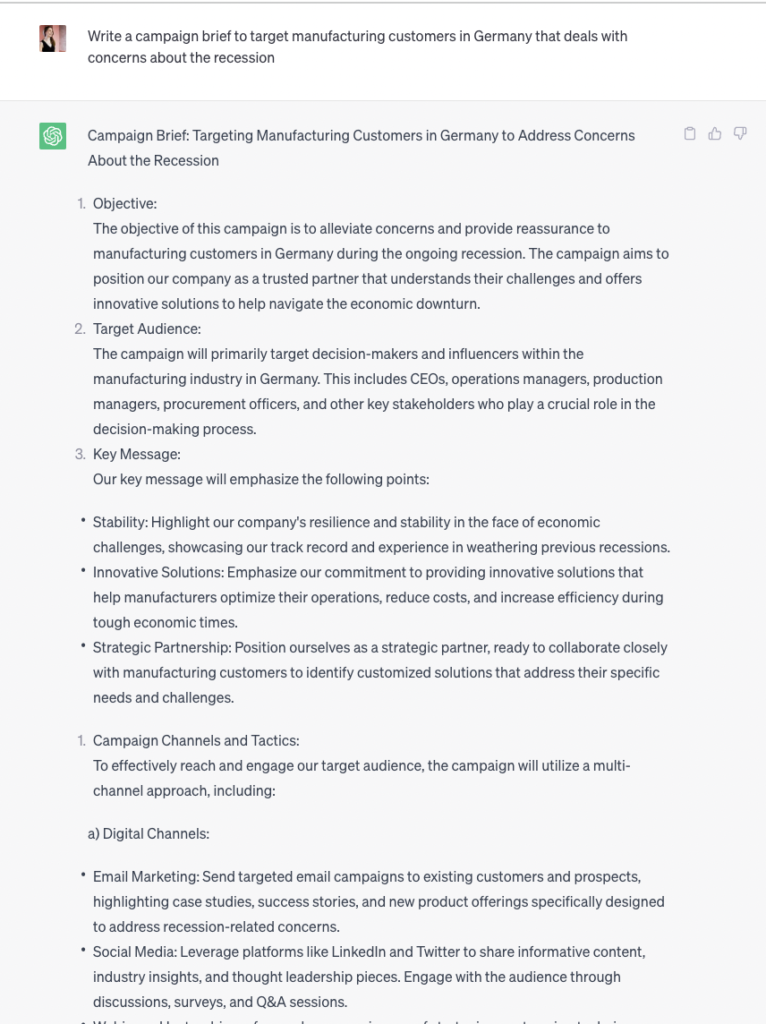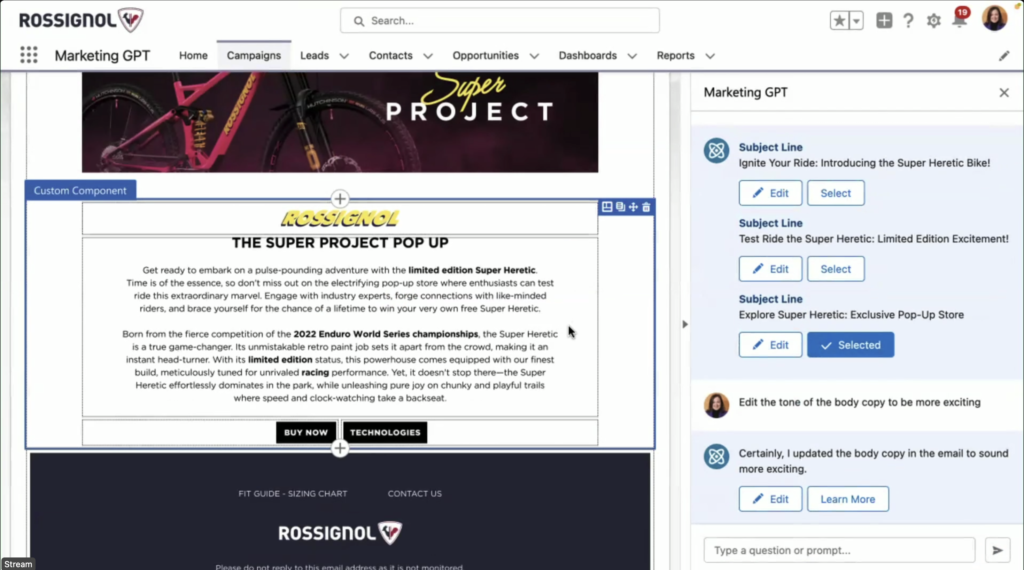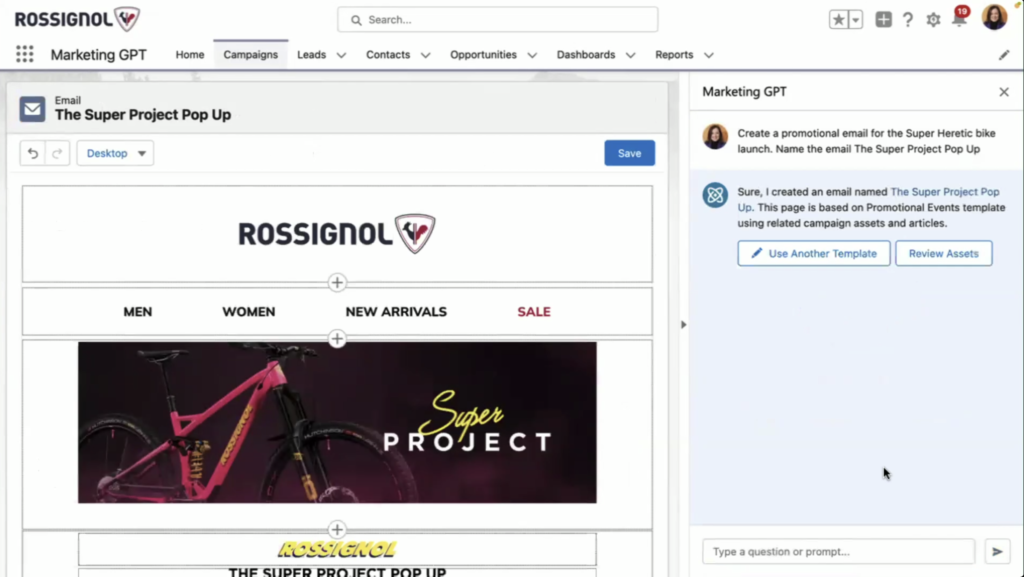In the past months, we’ve heard about the whirlwind of generative AI capabilities that are being brought to the Salesforce platform. With AI Cloud, and more specifically Marketing GPT, arriving on the scene, it’s a good time to talk about how the future could shape the roles of marketers working with the Salesforce platform.
Findings from Salesforce’s generative AI research are not surprising; the results compiled from 1,000+ marketers tie into the anecdotes we’re hearing. 51% of us are currently using generative AI – that’s over half of marketers who have either leveraged generative AI into workflows or are experimenting with it at work. An additional 22% plan to use it very soon.
Generative AI is not a ‘silver bullet’ answer – it can’t be implemented and be expected to make improvements to all use cases, nor to solve all challenges. With their GPT-enabled products, Salesforce is taking an intentional friction approach – in other words, no outputs from generative AI are being automatically applied into users’ workflows, requiring a ‘human in the loop’ at every stage. Salesforce say that they are being very intentional about adding friction in order for admins and other hands-on professionals to share in the understanding of how models are being used.
Now we’re warmed up on the current landscape, let’s dive into how GPT technology (Including ChatGPT) could have an impact on various marketing responsibilities, and why in most cases, there still needs to be a ‘human in the loop’.
Popular GPT Use Cases for Marketers
Currently, GPT is helping marketers with basic content creation, writing copy, inspiring creative thinking, analyzing market data, and generating image assets.
Looking to the future, it could help to analyze market and performance data, create groups or segments for marketing campaigns, create campaign and journey plans, personalize messaging, conduct copy testing, and build/optimize SEO strategy.
The use cases that I’ll cover in this guide fall into the groups ‘will support’, ‘can’t support’, and some where the lines are blurred. These are:
- Content Creation
- Inbound Marketing (Lead Funneling)
- Campaign Briefs
- Analytics
- Segment Creation
- Documentation
- Configuration/Architecting
- Campaign Execution
- User Adoption
Content Creation
GPT Impact Rating: High
By far the most talked about GPT use case in the marketing realm is content creation. The main reason for this is twofold; not only is creating content time-consuming, but there is also a huge demand placed on marketers to generate more variations of content.
- How GPT could have an impact: Creating multiple variations of content for testing and that all important ‘personalization’ (in this context, having multiple variations to show to prospects according to their profile and needs expressed). This was reflected in Salesforce’s Marketing GPT messaging when the announcement was made.
- Why there needs to be a ‘human in the loop’: Some thought leaders in the digital marketing space have been saying that you still need to have humans modifying content because the quality produced by AI isn’t anywhere near as good (however, almost in the same breath, they say that this could change in the next two to three years).
Take one of Marketing GPT’s use cases as a prime example, Salesforce gave Email Content Creation the tagline “with Einstein GPT, an email is just a sentence away”. With this, assisted experience enables marketers to build email body content, create subject lines, and more.
In action, as a marketer builds an email, they can:
- Generate messaging using content that was successful in past campaigns. This content delivery is powered by Data Cloud.
- Have GPT automatically add custom email components that are relevant to the prompt.
- Adjust copy and/or refine the tone rapidly. For example, they can generate three subject line variations, based on top performing emails. The marketer then has the decision making power to accept the suggestions, or they can opt to A/B test.
When generating content in a tool removed from your organization’s data (e.g. ChatGPT), the output is not contextual to your specific audience. As somewhat of a content marketer myself, I don’t feel threatened. There is so much knowledge people hold that’s waiting to be unlocked – useful knowledge that AI doesn’t have access to. In my line of work, this includes opinion articles, guides that discuss architectural considerations (opportunities and constraints), or content we consume that shares lived experiences from people.
Inbound Marketing (Lead Funneling)
GPT Impact Rating: High
- How GPT could have an impact: Chatbots will become more powerful in learning from previous conversations. This new wave of chatbots differs from the rules-based chatbots that have existed for some time – in other words, when setting up the chatbot, someone had to prescribe what the chatbot would answer to which questions/keywords.
- Why there needs to be a ‘human in the loop’: Deflecting queries is one thing, but the human touch is a strength that is incredibly powerful. You only need to read the messaging around Service GPT, which enables service reps with next best actions, not replacing their job. Marketers need to be keeping abreast with both inputs and outputs of GenAI chatbots, to continually improve their assets (e.g. their website), ensuring that prospects are getting answers to their questions, and escalating to a human when appropriate.
Campaign Briefs
GPT Impact Rating: Medium
- How GPT could have an impact: Certainly, ChatGPT can generate a campaign brief in a matter of seconds. You will have a structure that serves as a fantastic jumping off point.
- Why there needs to be a ‘human in the loop’: Again, this output is generic, and is not specific to your organization’s context, including the products/services you offer. With Einstein GPT, we’re already seeing use cases that advise on targeting (see Sales GPT’s Sales Emails feature, and Marketing GPT’s Email Content Creation feature).


Analytics
GPT Impact Rating: High
Personally speaking, this is the area that I’m most excited about. While Salesforce has done a good job of embedding query-based exploration into their analytics products, we marketers know that it’s not only Salesforce data that we’re querying every week. Here’s a tutorial that demonstrates a basic setup of plugging Google Analytics data into GPT.
- How GPT could have an impact: Imagine being able to create a repository of data and using prompts to surface what you need? This is what Marketing GPT’s Segment Intelligence for Data Cloud feature is getting at. Sifting through rows of data, or multiple pages in Google Analytics could become a thing of the past. I’ve heard others using Google Big Query + Open AI to achieve a more secure environment to perform queries with Google Analytics data.
- Why there needs to be a ‘human in the loop’: The answer to this is very simple: actioning insights. Moreover, there’s the ‘trust’ issue – do the results look right, or are anomalies being exacerbated? Are the inputs (i.e. data sources) still connected up correctly? These are just a couple of my thoughts on the topic.
Segment Creation
GPT Impact Rating: High
As the average organization collects data for more data points, and from more sources, creating highly impactful segments – to send the right message at the right time – will be something that will keep your organization competitive in the long run. Consider that it’s not only demographic data (data about the person) that is updating, but also behavioral data (data about what activities the person has made).
- How GPT could have an impact: Instructions to pull certain prospects/contacts matching certain criteria could work well.
- Why there needs to be a ‘human in the loop’: Actually understanding what you’re collecting, how you’re collecting it, and where it can be used, all contributes to determining the right segments that need to be targeted according to your organization’s requirements.
On a side note, our friends at DESelect, who have been pioneering better segmentation in Marketing Cloud, offer DESelect Engage which takes detecting/avoiding email fatigue to the individual Contact level – plus, they’re working on their own GPT-enabled segmentation offering.
Social Media
GPT Impact Rating: Medium
AI can elevate social media to determine strategic direction, foster human connection, and uncover customer perception. Two main areas are prospect/customer engagement to generate new business and loyalty, and social customer care, i.e. customers reaching out for assistance via social networks.
- How GPT could have an impact: Respond faster, accurately, with something valuable. GenAI use cases range from social content creation, generating suggested replies, determining optimal send times, identifying target customer segments, predicting customer behaviors, and optimizing pricing and product listings.
- Why there needs to be a ‘human in the loop’: Social media does need creativity to help brands stand out from the crowd. This reflects back to the ‘intentional friction’ approach, where a user still needs to validate the outputs for accuracy on what they want their brand to portray – now, they will be doing this efficiently, and at scale.
Documentation
GPT Impact Rating: Medium
I’ve said it before, and I will say it again – documentation is no one’s favorite job. The speed at which marketers are expected to move means that documentation is often left to the way-side.
However, creating documentation is the classic proverb “a stitch in time, saves nine” in action. Not only will documentation remind you of what happened during the multiple campaigns you’re juggling every year, but your future self will thank you when new team members join, or other stakeholders around the business want to understand what marketing is specifically doing in relation to your shared prospects/customers.
- How GPT could have an impact: Perhaps you have some notes that need to be summarized and refined? This could also be a Slack conversation that could be summarized, giving you the basis of what went well, what didn’t go so well, and recording the feedback at every stage.
- Why there needs to be a ‘human in the loop’: Obviously, ChatGPT can’t take the rich information that’s happening in all corners of the collaboration that occurs in your team. Plus, you will need to add/link to Salesforce records, such as Campaigns.
Configuration/Architecting
GPT Impact Rating: Low
To be clear, ‘configuration’ means making incremental changes to your Salesforce org/marketing automation tool, for example, adding/changing fields and their values, or deploying a new feature (e.g. Connected Campaigns). In other words, configuring is about taking the clicks-not-code (declarative) tools that Salesforce offer in order to adapt your Salesforce org.
‘Customization’, on the other hand, takes Salesforce beyond what is offered declaratively out-of-the-box, for example, extending functionality with Apex code. Furthermore, ‘architecting’ is the bigger picture for how your Salesforce environment grows and how your overall technology stack interacts with Salesforce, including the data model, how integrations are structured, and the data that flows in/out.
- How GPT could have an impact: Very little! There is no ‘one size fits all’ when it comes to CRMs and tailoring them to an organization’s needs.
- Why there needs to be a ‘human in the loop’: There really is no viable way that you can design your Salesforce org without understanding the business that will use it. You have insight into your organization’s unique characteristics, including the opportunities (e.g. future business objectives, resources available to make things happen) and constraints (e.g. budget, timelines to implement, customization that already exists that could impact how a solution is implemented).
Campaign Execution
GPT Impact Rating: Low
While you may be able to conjure up a brief with GPT and do amendments, actually acting on that is another story. This is a far-reaching topic, but what it ultimately comes down to is what data needs to exist to deliver personalized marketing, for other users to leverage, and to create the reports your organization needs. A couple of examples are:
- Connected Campaigns: How are campaigns syncing from Account Engagement to Salesforce, and how is the Campaign hierarchy structured to stitch together various marketing tactics into a cohesive picture?
- Campaign Members: How is marketing engagement reflected with Campaign Member Statuses, and what constitutes a meaningful interaction (and what does not)?
These are only a couple of examples that a marketer building marketing campaigns end-to-end with Salesforce and Account Engagement (Pardot) needs to have a solid understanding around – no doubt Marketing Cloud users can list off multiple, too!
- How GPT could have an impact: Research into how these features work.
- Why there needs to be a ‘human in the loop’: Even in the two examples above, you can see the types of decision-making that needs to be made, whereas GPT would be outputting typical or ‘cookie-cutter’ uses of those features.
User Adoption
GPT Impact Rating: Low
Salesforce adoption measures the extent to which users have incorporated Salesforce into their day-to-day tasks. Without users actually using Salesforce, the platform begins to become less of a ‘source of truth’ with stale or incomplete data.
- How GPT could have an impact: Similar to the point about documentation, you could leverage GPT to summarize large amounts of information about the solutions you’ve implemented, and potentially change the tone of the information to make it more understandable to a wider audience. If your internal communication goes unacknowledged, it could be a good time to rephrase it.
- Why there needs to be a ‘human in the loop’: User adoption is part of change management – in other words, how organizations implement and adopt changes, and then iterate upon them over time. Change management is very much a valuable soft skill that requires a human-to-human approach.
Summary
Bottom line, GPT can enable marketers to elevate their roles, but needs a foundation to start with where data specific to your organization exists. By accelerating the most time-consuming and mundane tasks, marketers are freed to flex their creative muscles not only by gaining efficiency in their days, but also by being able to scale content creation to achieve more advanced personalization.
What GPT could support:
- Content creation (e.g. variations)
- Inbound marketing (lead funneling)
- Campaign briefs
- Analytics
- Segment creation
- Documentation
What GPT can’t support:
- Configuration/Architecting
- Campaign execution
- User adoption
This Pardot article written by:
Salesforce Ben | The Drip
Lucy Mazalon is the Head Editor & Operations Director at Salesforceben.com, Founder of THE DRIP and Salesforce Marketing Champion 2020.
Original Pardot Article: https://www.salesforceben.com/the-drip/can-chatgpt-replace-a-salesforce-marketer/
Find more great Pardot articles at www.salesforceben.com/the-drip/
Pardot Experts Blog
We have categorized all the different Pardot articles by topics.
Pardot Topic Categories
- Account Based Marketing (ABM) (8)
- Business Units (13)
- ChatGPT / AI (3)
- Completion Actions (5)
- Connectors (10)
- Custom Redirects (4)
- Demand Generation (8)
- Dynamic Content (5)
- Einstein Features (11)
- Email Delivery (18)
- Email Open Rates (3)
- Pardot A/B Testing (2)
- Email Mailability (16)
- Do Not Email (1)
- Double Opt-in (2)
- Opt Out / Unsubscribe (14)
- Email Preferences Page (6)
- Engagement Studio (14)
- Industries (1)
- Non Profit (1)
- Landing Pages (10)
- Lead Generation (1)
- Lead Management (12)
- Lead Routing (2)
- Lead Scoring (15)
- Leads (3)
- Marketing Analytics – B2BMA (9)
- Marketing Automation (1)
- Marketing Cloud (2)
- Marketing Cloud Account Engagement (4)
- New Pardot Features (6)
- Opportunities (2)
- Optimization (3)
- Pardot Admin (62)
- Duplicates (1)
- Marketing Ops (1)
- Pardot Alerts (1)
- Pardot API (2)
- Pardot Automations (3)
- Pardot Careers (12)
- Pardot Certifications (4)
- Pardot Consulting (1)
- Pardot Cookies (3)
- Pardot Custom Objects (3)
- Pardot Email Builder (7)
- Pardot Email Templates (9)
- HML (6)
- Pardot Events (16)
- Pardot External Actions (1)
- Pardot External Activities (4)
- Pardot Forms (27)
- Form Handlers (7)
- Pardot Integrations (21)
- Data Cloud (1)
- Slack (1)
- Pardot Lead Grading (5)
- Pardot Lead Source (2)
- Pardot Lightning (1)
- Pardot Migration (1)
- Pardot Nurture / Drip Campaigns (1)
- Pardot Personalization (3)
- Pardot Profiles (1)
- Pardot Releases (19)
- Pardot Sandboxes (2)
- Pardot Segmentation (4)
- Pardot Strategy (7)
- Pardot Sync (2)
- Pardot Sync Errors (1)
- Pardot Tracker Domains (5)
- Pardot Training (3)
- Pardot Vs Other MAPs (4)
- Pardot Website Tracking (2)
- Reporting (22)
- Salesforce and Pardot (29)
- Marketing Data Sharing (2)
- Pardot Users (3)
- Salesforce Automation (4)
- Salesforce Flows (1)
- Salesforce Campaigns (20)
- Salesforce CRM (3)
- Record Types (1)
- Salesforce Engage (3)
- Salesforce Queues (2)
- Security and Privacy (1)
- Tags (3)
- The Authors (483)
- Cheshire Impact (9)
- Greenkey Digital (47)
- Invado Solutions (37)
- Jenna Molby (9)
- Marcloud Consulting (6)
- Nebula Consulting (53)
- Pardot Geeks (38)
- Salesforce Ben | The Drip (235)
- SalesLabX (2)
- Slalom (2)
- Unfettered Marketing (45)
- Uncategorized (1)
- Website Tracking (2)
- Website Search (1)
More Pardot Articles
See all posts
This Pardot article written by:
Salesforce Ben | The Drip
Lucy Mazalon is the Head Editor & Operations Director at Salesforceben.com, Founder of THE DRIP and Salesforce Marketing Champion 2020.
Original Pardot Article: https://www.salesforceben.com/the-drip/can-chatgpt-replace-a-salesforce-marketer/
Find more great Pardot articles at www.salesforceben.com/the-drip/




